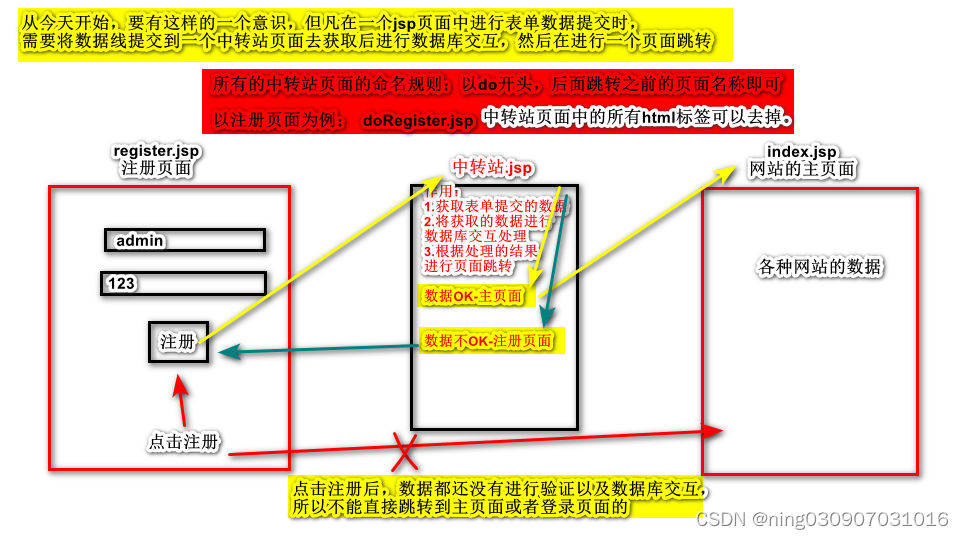一、页面跳转方式
(1)javascript方式跳转
window.location.href = "跳转的地址"
(2)java方式跳转
① 转发
1.1 概述
由服务器端进行的页面跳转
1.2 方法
(1)获取转发器RequestDispatcher rd = request.getRequestDispatcher("/跳转的地址")
(2)实现转发转发器对象.forward(request,response);
通常简写: request.getRequestDispatcher("/跳转的地址").forward(request,response);
1.3 特点
(1)地址栏不发生变化,显示的是上一个页面的地址
(2)请求次数:只有1次请求,因为转发是服务端行为。
(3)根目录:http://localhost:8080/项目地址/,包含了项目的访问地址
(4)请求域中数据不会丢失
② 重定向
2.1 概述
由浏览器端进行的页面跳转
2.2 方法
response.sendRedirect("要跳转的地址");
2.3 特点
(1)地址栏:显示新的地址
(2)请求次数:2次
(3)根目录:http://localhost:8080/ 没有项目的名字
(4)请求域中的数据会丢失,因为是2次请求
③ 注意事项
3.1 什么时候使用转发,什么时候使用重定向?
如果要保留请求域中的数据,使用转发,否则使用重定向。
以后访问数据库,增删改使用重定向,查询使用转发。
3.2 转发或重定向后续的代码是否还会运行?
无论转发或重定向后续的代码都会执行
④ 重定向和转发的区别
<% //设置编码格式 request.setCharacterEncoding("utf-8"); //获取用户名和密码 String username = request.getParameter("username"); String password = request.getParameter("password"); if("admin".equals(username)){ out.println("<script>"); out.println("alert('该用户已被注册,请重新进行注册');"); out.println("location.href='register.jsp'"); out.println("</script>"); }else{//可以注册 //直接可以跳转到index.jsp /* 通过location页面跳转 */ out.println("<script>"); out.println("location.href='index.jsp'"); out.println("</script>"); /* 通过Java的方式 转发进行跳转 */ //response 内置对象 响应 request.getRequestDispatcher("index.jsp").forward(request, response); /* 通过Java的方式 重定向进行跳转 */ response.sendRedirect("index.jsp"); /* lcoation和重定向(response.sendRedirect("index.jsp");)是一样 地址栏发生改变,数据不会保留 */ /* 转发 地址栏不会发生改变,数据会保留 可以通过request对象进行获取。 */ request.getRequestDispatcher("index.jsp").forward(request, response); } %>(3)超链接方式
<a href = "路径">资源地址</a>
携带参数的注意事项: 第一个参数之前 (?) 参数与参数之间使用(&)
<!-- 携带参数的注意事项: 第一个参数之前 (?) 参数与参数之间使用(&) --> <a href = "index.jsp?username=admin&password=123">跳转到主页</a> <!-- js跳转 --> <hr/> <!-- 通过location跳转可以携带参数 后面可以通过request对象进行获取 --> <button onclick = "add();">跳转到index.jsp</button> <script type="text/javascript"> function add(){ /* 通过js的location对象进行页面跳转 */ location.href = "index.jsp?result=123"; } </script>
二、JDBC API
(1)主要功能
与数据库建立连接、执行SQL 语句、处理结果
(2)常用对象
① DriverManager
依据数据库的不同,管理JDBC驱动
② Connection
负责连接数据库并担任传送数据的任务
③ PreparedStatement
由 Connection 产生、负责执行SQL语句
④ ResultSet
负责保存Statement执行后所产生的查询结果
(3) java通过jdbc连接Oracle数据库进行交互的步骤
1、加载JDBC驱动
Class.forName(JDBC驱动类);
2、与数据库建立连接
Connection conn=DriverManager.getConnection("jdbc:oracle:thin:@127.0.0.1:1521:orcl","scott","admin");
3、发送SQL语句,并得到返回结果
4、处理返回结果
5、释放资源<%@page import="java.sql.ResultSet"%> <%@page import="java.sql.PreparedStatement"%> <%@page import="java.sql.DriverManager"%> <%@page import="java.sql.Connection"%> <%@ page language="java" contentType="text/html; charset=UTF-8" pageEncoding="UTF-8"%> <% //1.设置编码 request.setCharacterEncoding("utf-8"); //2.获取数据 String username = request.getParameter("username"); String password = request.getParameter("password"); //进行Oracle数据库交互 //定义两个变量存储用户名以及密码 String uname = ""; String pwd = ""; //连接对象定义 Connection conn = null; PreparedStatement ps = null;//执行对象 //结果集对象 ResultSet rs = null; try{ //加载驱动 Class.forName("oracle.jdbc.driver.OracleDriver"); //b.建立连接 String url = "jdbc:oracle:thin:@localhost:1521:orcl"; conn = DriverManager.getConnection(url, "scott", "123"); //编写sql语句传入执行方法返回执行对象 String sql = "select * from tb_users where username = ? and upassword = ?"; ps = conn.prepareStatement(sql); //占位符赋值 ps.setString(1, username); ps.setString(2, password); //返回结果集对象 rs = ps.executeQuery(); //遍历或者判断 if(rs.next()){ uname = rs.getString(2); pwd = rs.getString(3); } }catch(Exception e){ e.printStackTrace(); }finally{ if(conn!=null&&!conn.isClosed()){ conn.close(); } if(ps!=null){ ps.close(); } if(rs!=null){ rs.close(); } } if(uname!="" && pwd!=""){ out.println("<script>alert('你已注册,请登录');location.href='login.jsp';</script>"); }else{ request.getRequestDispatcher("registerhome.jsp").forward(request, response); } %>







 本文详细介绍了Java Web中页面跳转的两种方式——转发和重定向,包括它们的特点和应用场景。同时,讲解了JDBC API的主要功能、常用对象以及通过JDBC连接Oracle数据库进行数据交互的步骤。
本文详细介绍了Java Web中页面跳转的两种方式——转发和重定向,包括它们的特点和应用场景。同时,讲解了JDBC API的主要功能、常用对象以及通过JDBC连接Oracle数据库进行数据交互的步骤。




















 被折叠的 条评论
为什么被折叠?
被折叠的 条评论
为什么被折叠?










